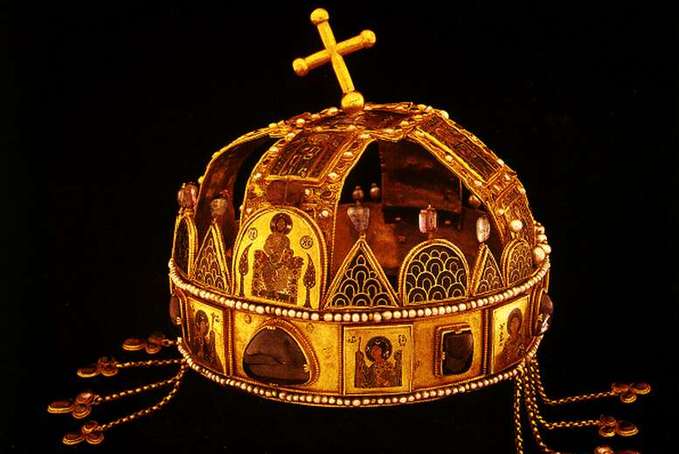Medieval Hungarian-Ottoman contacts began in the 14th century, and the new conquerors of the Balkans were strongly concerned with the identity of their strongest opponent. Of course, the image of the Hungarians' past has changed over time.
, a story was recorded in Muslim mythology to King Seddád In 1529, Ibrahim Pasha presented the Hungarian crown in the divan, which he believed originally Nusinreván (i.e. Hoszrau II) (AD 531-579). The theory then developed rapidly, in 1543 it was already claimed that the crown from Alexander the Great to the famous Sassanid ruler and from there to the Hungarians. And in the 1650s, Evlia Cselebi goes even further: according to him, the crown Hósang Shahe , the first crowned king of Iranian mythology, from whom it came to the above-mentioned kings. Ultimately, these crown histories were meant to prove that this object with great legitimizing power came from the East - from the "Muslim world" - and, moreover, it came to the Hungarians the second time from the hands of Sultan Süleymán , and therefore the Habsburgs illegally possess it. Its recovery - and the support of the Hungarians in this - is therefore completely justified.
Parallel to the history of the crown, the perception of the Hungarian people also evolved. The Ottomans knew - either from Hungarian chronicles or from Muslim geographical literature - that the Hungarians came from the east. On the one hand, they were connected to the Tatars: "The Hungarians came from the Tatars who lived on the banks of the Don", writes Ebu Bekr bin Behrám Dimiski mentioned by the author of Tarih-i Ungurusz, Mahmud Terdzümán after the middle of the 19th century: according to him, Hunor, the ancestor of the Hungarians, was married to the daughter of the Tatar khan. And that this was not only a secret of the philosophers' workshop, is shown by the report of Voivode Mihály Havasalföldi, according to which the Tatar envoys who were negotiating with him, when the good wines solved their language, spoke like this: "Why would we fight against the Hungarians, since we are relatives and from the same lineage, we come from the race of the Scythians.”
At the same time, in relation to the crown, Evlia Cselebi tells a completely different story about the origin of the Hungarians: the four sons of the king of Persian mythology Menucsehr , who were forced to flee their homeland, founded a state in the Carpathian basin. The Hungarians are therefore Persian in terms of their origin, which he claims is proven by the ethno-etymological analysis of the name, a series of Persian words, and the fact that a drawing of the Hungarian Holy Crown can be seen on Shah Hósang's tomb in Dagestan. We do not know how old this idea is, in any case, it cannot be ruled out that Evlia herself built it from the data available to her. The Ottoman propaganda machine even tried to use the pre-Hungarian history of the Carpathian Basin for its own purposes. A legend dating back to the middle of the 16th century recounted the Pannonian conquests of Alexander the Great Alexander - in Muslim mythology Alexander - is the world conqueror who, although he lived before Muhammad, worked on the spread of Islam through an inspiration. The Ottoman sultans followed in his footsteps, which is why they called themselves Alexander the Second. The Persian past was then already integrated into Muslim traditions, just as the Greek past also became part of the Ottoman imperial tradition. Alexander's alleged Pannonian conquests thus provided a legal basis for new wars: this is how repossessions became repossessions. dealt with Plato's , which was also highly valued by Muslims With this capture, the Ottomans also wanted to acquire the past of Hungary. This was not the first time they acted like this, they came up with a similar legend in the case of Byzantium as well. [1]
Géza Pálffy's research, Sülejmán did not take the Holy Crown with him to Istanbul after all, but left it here in the country due to power struggles. He writes about it like this:
so far, even after the Battle of Mohács in 1526, the Hungarian crown could not be guarded for a long time by "ordinary crown guards", i.e. Hungarian lords according to the customs of the late Middle Ages. But he also had to leave Visegrád, his stronghold until then, several times. As on many occasions in previous centuries, the coat of arms once again became a defining part of the struggle of those aspiring to the Hungarian throne and those fighting for the territory of Hungary, and even an outstanding political asset. After the defeat in Mohács, he was briefly taken refuge in the castle of Trencsén, and then after the coronation of the Transylvanian voivode János Szapolyai Péter Perényi , took him to his own castle in Füzér in northeastern Hungary - apparently with the consent of the new ruler.
Perényi was perfectly aware of the legitimating power of the crown, and he used its possession excellently to build his own career. On November 3, 1527, for the coronation of another Hungarian king, Ferdinand Habsburg, he provided Fehérvár with the insignia of majesty, in exchange for new offices (e.g. the Transylvanian voivodeship) and estates. Contrary to the claims of contemporary historians, however, our crown did not remain in Perényi's possession in Baranya county after that, but returned to Visegrad.
It was acquired here by Sultan Süleymán in the summer of 1529, during his campaign against Vienna. After the failure of this, he first decided to take both the crown and the captured Hungarian dignitaries to Istanbul with him - Archbishop Pál Várday of Esztergom and Crown Guard Perényi - but they presumably explained to him that legitimate royal power in Hungary is unthinkable without the Holy Crown. Therefore, on his way home at the beginning of October 1529, the sultan sent back the insignia of his majesty to his Hungarian vassal, King János, from the border of the village of Tass on the Danube, and released the political hostages. He obviously realized: Only the possession of the Holy Crown can secure his Szapolyas, and then any successors, in the ruling power.
The fact that the sultan did not take the Holy Crown away from Hungary even after the famous capture of Buda (August 29, 1541) testifies to the same.
From Emma Bartoniek's book:
Sülejmán handed over the Holy Crown to the Zápolyans who came to pay homage to him. Our Holy Crown remained with János until his death, when it was inherited by his widow, Queen Isabella , who, in 1551, the peace mediated by Friar György Ferdinand I , gave the Holy Crown to her. he abdicated the Hungarian throne on behalf of himself, his son Zsigmond János The Holy Crown was taken by the imperial general Castaldo In Ferdinand's possession, our Holy Crown did not remain permanently in the country. A large part of the country fell into Turkish hands, and it was precisely those areas that our Holy Crown had guarded until now. During the Habsburg era, therefore, the Crown and other insignia were predominantly kept in the strong castle of Bratislava, but it also happened, namely under Ferdinand I, that the expensive insignia were taken to Vienna and even to Prague, the favored seat of the Habsburgs at that time, according to the king he was staying there, or he saw it as safer from the Turkish danger and the attacks of his sometimes hot-tempered subjects.
In 1606, the Peace of Vienna obliged Mátyás , the future king, to bring the Holy Crown back to Hungary when more peaceful times came and keep it in Bratislava (1606. 4. tc.) as well as 1608. 4. tc., which made the Holy Crown corona regni he calls it the crown of the country. Rudolf kept our Holy Crown in his permanent residence in Hradzin in Prague and did not want to give it away, but at the insistence of Archduke Mátyás he finally had to give in. This, on the other hand, only wanted to keep the country's crown in Austria, because he could rightfully fear that if it was in the country, it would fall into the hands of one of the "rebellis", who might crown himself with it. After more or less tug-of-war, the will of the country finally prevailed: on June 12, 1608, Rudolf handed over the casket containing the Holy Crown with great ceremony to Archduke Mátyás and a large number of brightly armed Hungarian deputations , and after the coronation, II. According to Article 16 of the post-coronation laws of 1608, Mátyás takes the Holy Crown together with the coronation insignia to Bratislava Castle.
The XVII. s. during the Bethlen uprising in 1618, the Péter Révay was forced to hand over the Holy Crown to the insurgents, and thus in the hands of the Bethlen first it went to Zólyom castle, then to Kassa, from there to Eperjes, and finally to Ecsed, Szabolcs county, as soon as Bethlen retreated from Ferdinand forced. Under the terms of the Nikolsburg Peace of June 1621, the Holy Crown again II. It came into the possession of Ferdinand.












